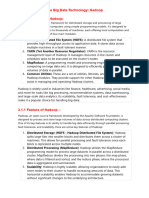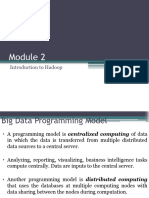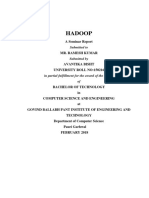Assignment 5 (Hadoop)
Uploaded by
hapiness1131Assignment 5 (Hadoop)
Uploaded by
hapiness1131Assignment-5
Hadoop: Hadoop is an open-source framework designed to handle large-scale data processing and storage across
clusters of commodity hardware. It consists of two main components: the Hadoop Distributed File System (HDFS) for
storing data across multiple machines, and the MapReduce programming model for processing and analyzing this
data in parallel. Hadoop enables organizations to effectively manage and analyze vast amounts of data, offering
scalability, fault tolerance, and cost-effectiveness.
1. Big Data Handling: Hadoop is a framework designed to handle large volumes of data, often referred to as "Big
Data." This data is typically too large or complex to be processed using traditional methods.
2. Distributed Processing: Instead of relying on a single powerful machine to process data, Hadoop distributes the
workload across a cluster of computers. Each computer in the cluster (called a node) works on a portion of the data
simultaneously.
3. Hadoop Distributed File System (HDFS): HDFS is the storage component of Hadoop. It breaks data into smaller
chunks and distributes them across the cluster. This redundancy ensures that even if a node fails, the data remains
accessible.
4. MapReduce: MapReduce is a programming model used by Hadoop to process and analyze the data stored in HDFS.
It consists of two main phases: the Map phase, where data is divided into smaller chunks and processed in parallel,
and the Reduce phase, where the results from the Map phase are combined to produce the final output.
5. Fault Tolerance: Hadoop is designed to be fault-tolerant, meaning it can continue to operate even if some nodes in
the cluster fail. This is achieved through data replication and job reassignment to healthy nodes.
6. Scalability: Hadoop is highly scalable, meaning it can easily accommodate an increase in data volume by simply
adding more nodes to the cluster. This allows organizations to expand their data infrastructure as needed without
significant disruptions.
7. Cost-Effectiveness: Hadoop runs on commodity hardware, meaning it doesn't require expensive, specialized
equipment. This makes it a cost-effective solution for organizations looking to manage and analyze large volumes of
data without breaking the bank.
8. Ecosystem: Hadoop has a rich ecosystem of tools and libraries that extend its functionality. These include tools for
data ingestion, storage, processing, and analysis, as well as integration with other technologies like Apache Spark,
Apache Hive, and Apache HBase.
9. Use Cases: Hadoop is used in various industries and applications, including but not limited to, web analytics, social
media analysis, fraud detection, recommendation systems, and scientific research.
10. Challenges: While powerful, Hadoop also presents challenges, such as complexity in setup and maintenance,
programming complexity with MapReduce, and the need for specialized skills to effectively utilize its capabilities.
You might also like
- Víctor Olaya - ''A Gentle Introduction To SAGA GIS (Edition 1.1) ''No ratings yetVíctor Olaya - ''A Gentle Introduction To SAGA GIS (Edition 1.1) ''217 pages
- Report On An Exploratory Analysis of TheNo ratings yetReport On An Exploratory Analysis of The19 pages
- Hadoop Is A Framework That Is Widely Used For Storing and Managing Big DataNo ratings yetHadoop Is A Framework That Is Widely Used For Storing and Managing Big Data2 pages
- HADOOP ECOSSYTEM, COMPONENTS, Loading, Getting Data From HadoopNo ratings yetHADOOP ECOSSYTEM, COMPONENTS, Loading, Getting Data From Hadoop10 pages
- Mobile Location Based Attendance SystemNo ratings yetMobile Location Based Attendance System19 pages
- (7465) Covid Patients Tracing Web ApplicationNo ratings yet(7465) Covid Patients Tracing Web Application6 pages
- 9AKK105713A6951 ABB MNS Is - Product PresentationNo ratings yet9AKK105713A6951 ABB MNS Is - Product Presentation24 pages
- Topic Identification of Instagram Hashtag Sets For Image Tagging: An Empirical AssessmentNo ratings yetTopic Identification of Instagram Hashtag Sets For Image Tagging: An Empirical Assessment12 pages
- CAT4-5 - Soluções de Cabeamento e Migração Do Sistema PLC - DCSNo ratings yetCAT4-5 - Soluções de Cabeamento e Migração Do Sistema PLC - DCS312 pages
- 2PGDCA3A Unit II DTP With Page Maker and PhotoshopNo ratings yet2PGDCA3A Unit II DTP With Page Maker and Photoshop10 pages
- Assignment Dca (Computer in Office Ii MS PPT Access & Outlook) 104No ratings yetAssignment Dca (Computer in Office Ii MS PPT Access & Outlook) 1045 pages
- 10.2.4.5 Lab Troubleshooting Multi Area OSPFv2 and OSPFv3No ratings yet10.2.4.5 Lab Troubleshooting Multi Area OSPFv2 and OSPFv38 pages
- Standards Association of Zimbabwe Iso 9001:2015 Qms Certification QuestionnaireNo ratings yetStandards Association of Zimbabwe Iso 9001:2015 Qms Certification Questionnaire2 pages
- The Refinedweb Dataset For Falcon LLM: Outperforming Curated Corpora With Web Data, and Web Data OnlyNo ratings yetThe Refinedweb Dataset For Falcon LLM: Outperforming Curated Corpora With Web Data, and Web Data Only32 pages
- Data Governance A Conceptual Framework in Order To Prevent Your Data Lake From Becoming A Data SwampNo ratings yetData Governance A Conceptual Framework in Order To Prevent Your Data Lake From Becoming A Data Swamp45 pages
- ۔ماہنامہ الہلال۔۔شعبان المعظم 1442ھ PDFNo ratings yet۔ماہنامہ الہلال۔۔شعبان المعظم 1442ھ PDF95 pages

























































































